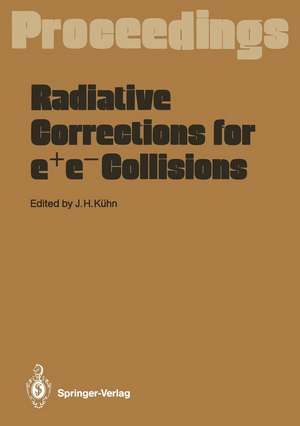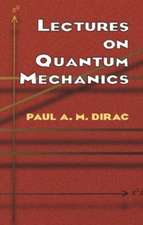Radiative Corrections for e+e- Collisions: Proceedings of the International Workshop Held at Schloß Ringberg Tegernsee, FRG, April 3–7, 1989
Editat de Johann H. Kühnen Limba Engleză Paperback – 22 aug 2014
Preț: 394.71 lei
Nou
Puncte Express: 592
Preț estimativ în valută:
75.53€ • 80.77$ • 62.97£
75.53€ • 80.77$ • 62.97£
Carte tipărită la comandă
Livrare economică 17 aprilie-01 mai
Preluare comenzi: 021 569.72.76
Specificații
ISBN-13: 9783642749278
ISBN-10: 3642749275
Pagini: 360
Ilustrații: VIII, 349 p. 9 illus.
Dimensiuni: 170 x 244 x 19 mm
Greutate: 0.57 kg
Ediția:Softcover reprint of the original 1st ed. 1989
Editura: Springer Berlin, Heidelberg
Colecția Springer
Locul publicării:Berlin, Heidelberg, Germany
ISBN-10: 3642749275
Pagini: 360
Ilustrații: VIII, 349 p. 9 illus.
Dimensiuni: 170 x 244 x 19 mm
Greutate: 0.57 kg
Ediția:Softcover reprint of the original 1st ed. 1989
Editura: Springer Berlin, Heidelberg
Colecția Springer
Locul publicării:Berlin, Heidelberg, Germany
Public țintă
ResearchDescriere
In recent years the Standard Model of electroweak interactions has successfully passed a number of crucial tests, most notably in neutral current reactions and through the observation of W- and Z-bosons in proton-antiproton collisions. How ever, experiments are only beginning to verify one of the most basic consequences of its theoretical formulation as a local quantum field theory: quantum corrections as calculated in perturbation theory. Measurements that will be carried out at electron positron colliders at Stanford and CERN in the very near future will improve the accuracy by more than an order of magnitude. Thus either these crucial elements of the present theoretical framework will be confirmed or the road to physics beyond the Standard Model will be opened. A huge amount of theoretical work has been invested during the past few years to match the envisaged experimental precision. QED corrections, in particular from initial state radiation, will playa dominant role in the interpretation of measurements and have to be understood at a hitherto unrivalled level of accuracy. Analytical cal culations - either to a fixed order in a or by summing large logarithms to arbitrary order - are complementary to recent developments of Monte Carlo techniques in the simulation of events with multiple photon emission. Measurements with hadronic final states evidently require the understanding of hadronic corrections to high accu racy. Even purely leptonic reactions are influenced by hadronic interactions through vacuum polarization.
Cuprins
I: QED and Hadronic Corrections, Monte Carlo Programs.- Applications of Renormalization Group Methods to Radiative Corrections.- Structure Function Techniques in e+e- Collisions.- The Z Line Shape.- Uncertainties from Light Quark Loops.- Hadron Physics and Radiative Corrections.- Electroweak Monte Carlos for LEP: A Status Report.- The Exclusive Exponentiation in the Monte Carlo — The Case of Initial State Bremsstrahlung.- Apol as Test of the Standard Model at LEP.- lI: Electroweak Corrections.- The Z Boson Width: Higher Order Effects and Influence on the Z Line Shape.- On the Derivation of Standard Model Parameters from the Z Peak.- Radiative Corrections in the Standard Model and the Rho Parameter.- Radiative Corrections to Boson Pair Production in e+e- Annihilation.- Radiative Corrections to W-Pair Production at LEP.- III: Beyond the Standard Model.- Searches for a New Gauge Boson at Different LEP Phases.- A Simple Renormalization Framework for SU(2)L X U(1)Y X ?(L) Models.- IV: Experimental Strategies.- Precision Measurement of Electroweak Parameters at the Stanford Linear Collider.- What Can We Learn from the Z Line Shape? An Experimentalist’s Survey.- The First Three Months.- Results on R in e+e- Annihilation.- Precision Measurements of Quark Asymmetries.- Physics with the Pretzel LEP.- Participants.
















